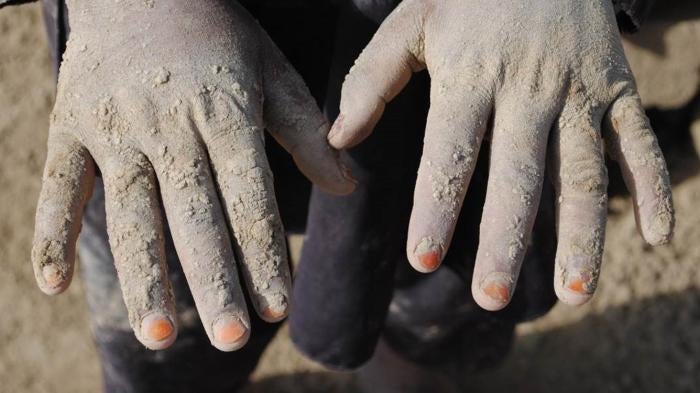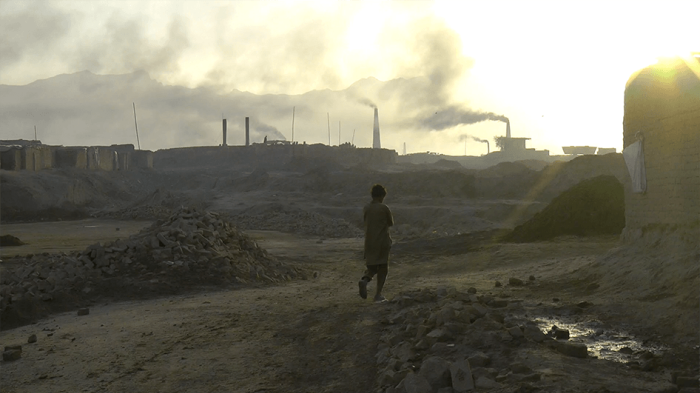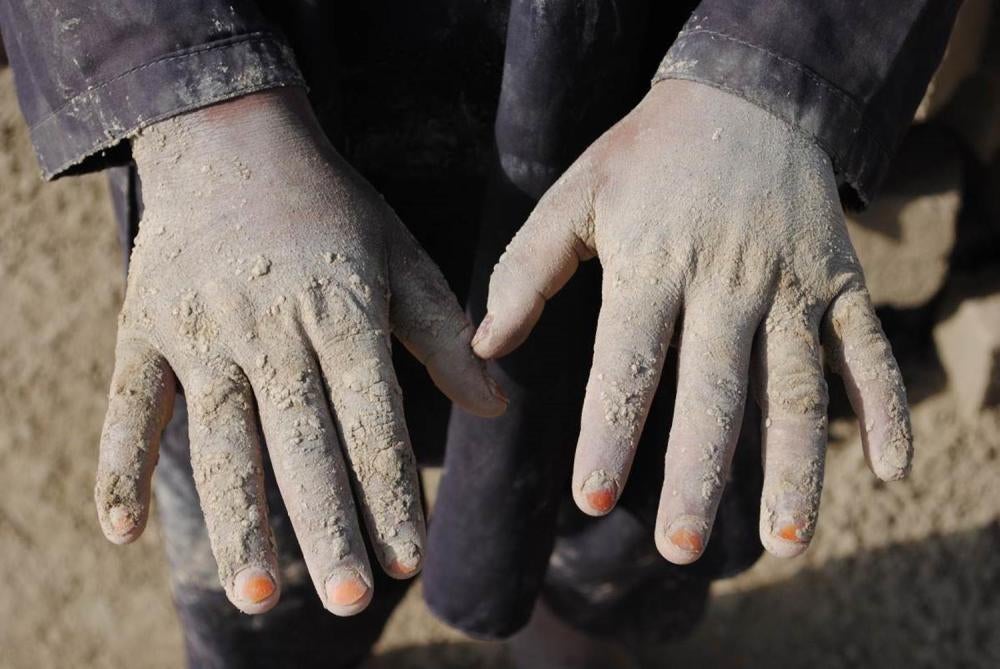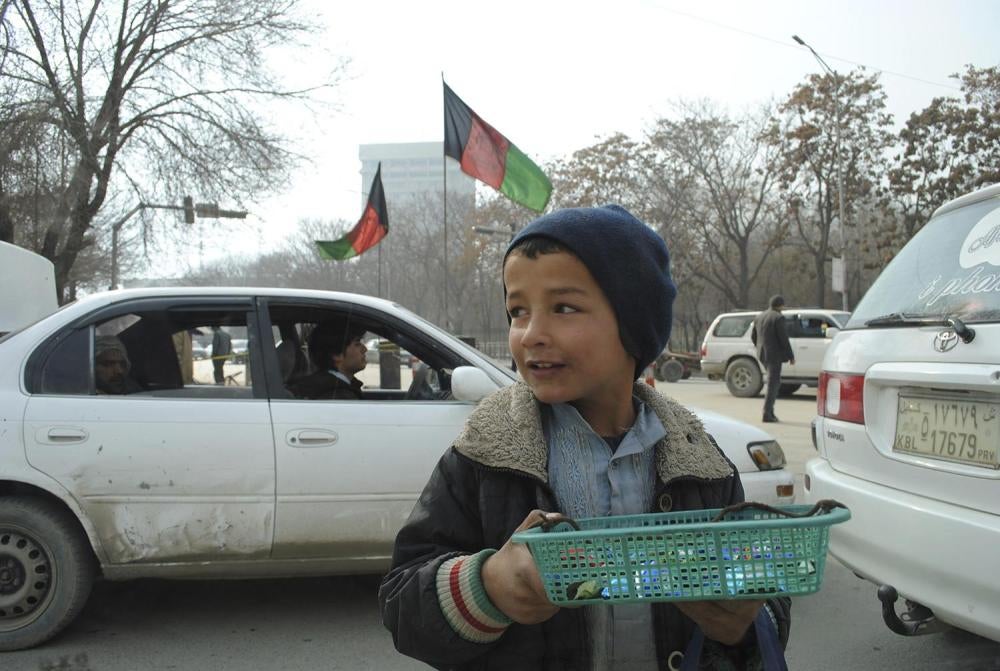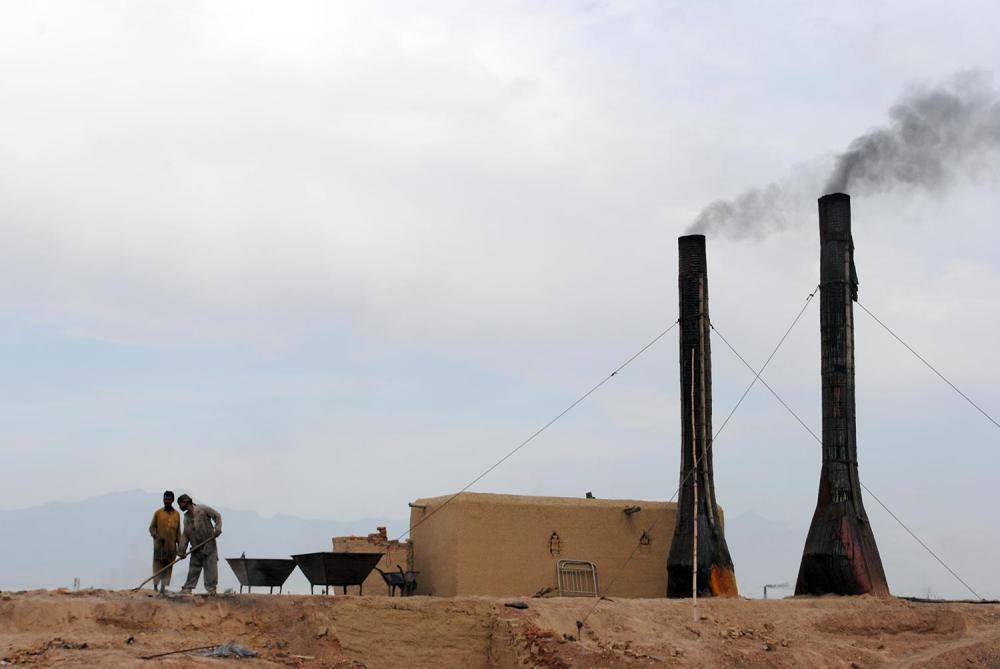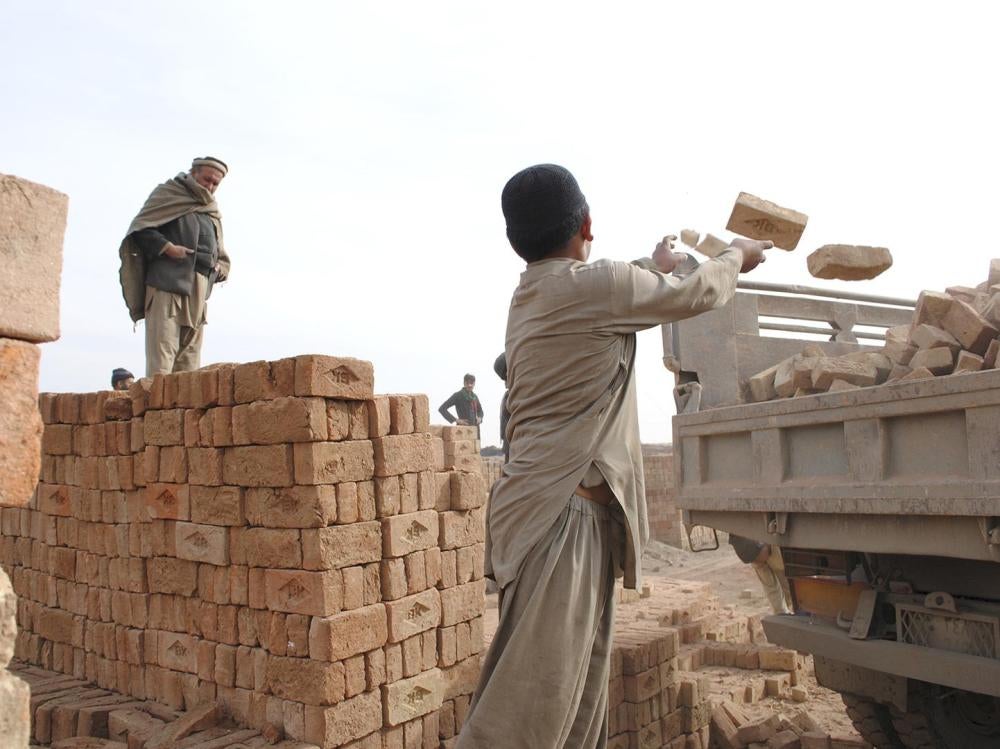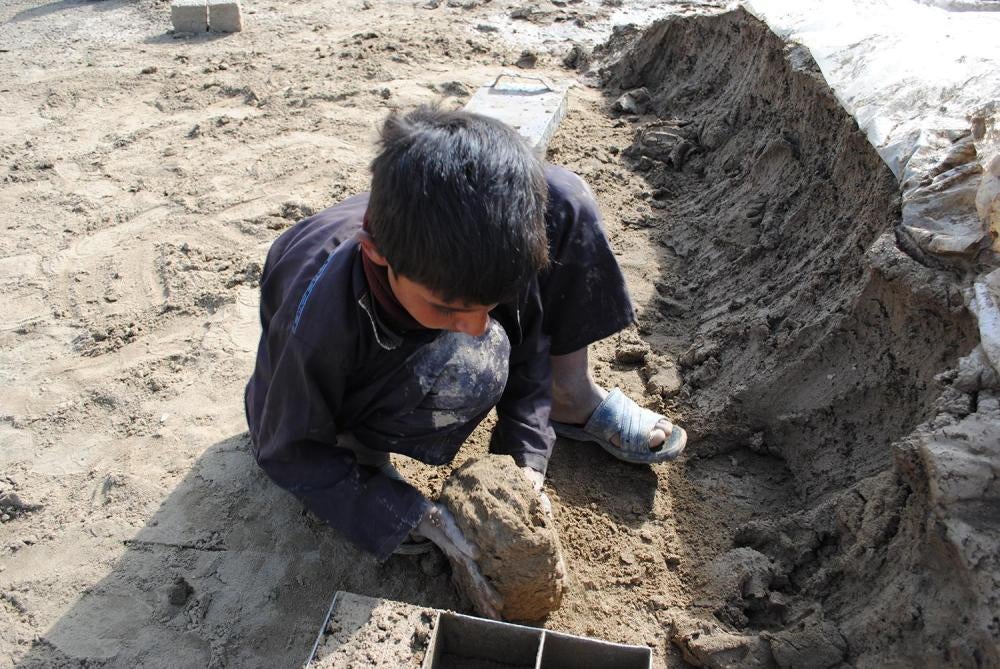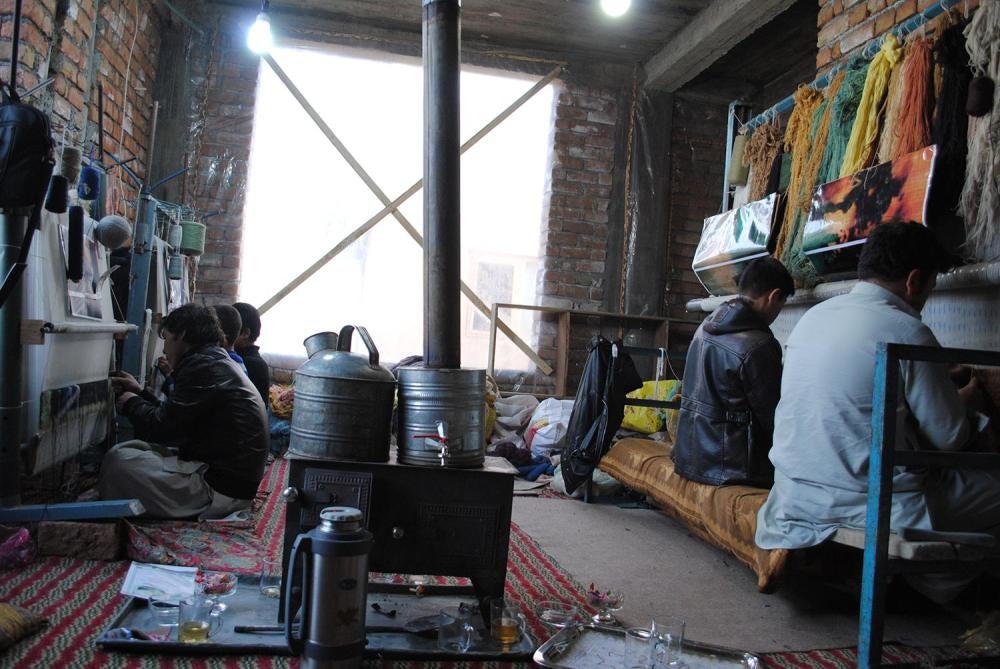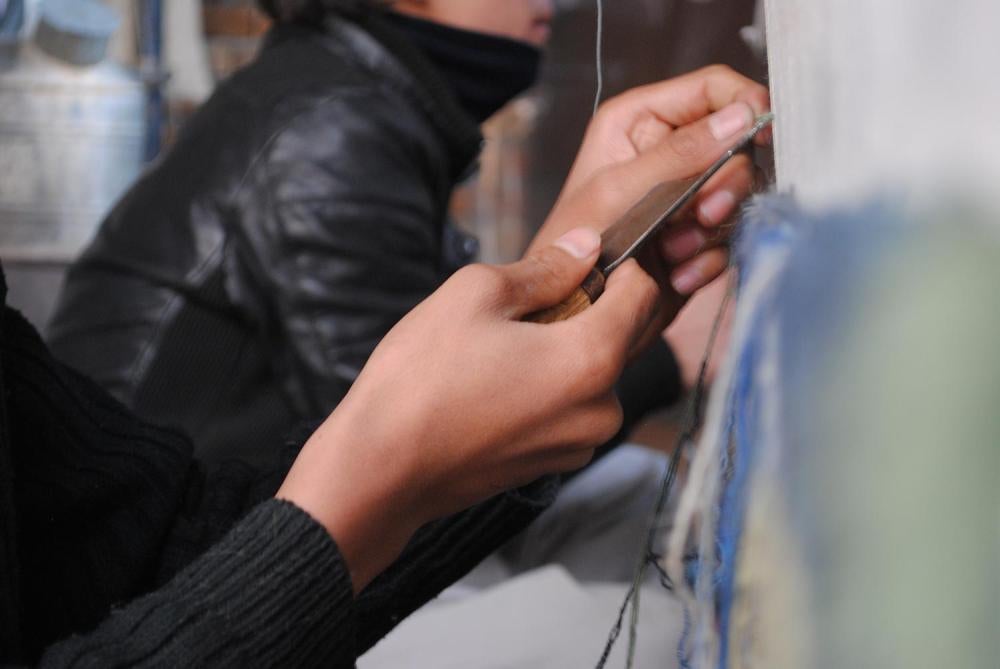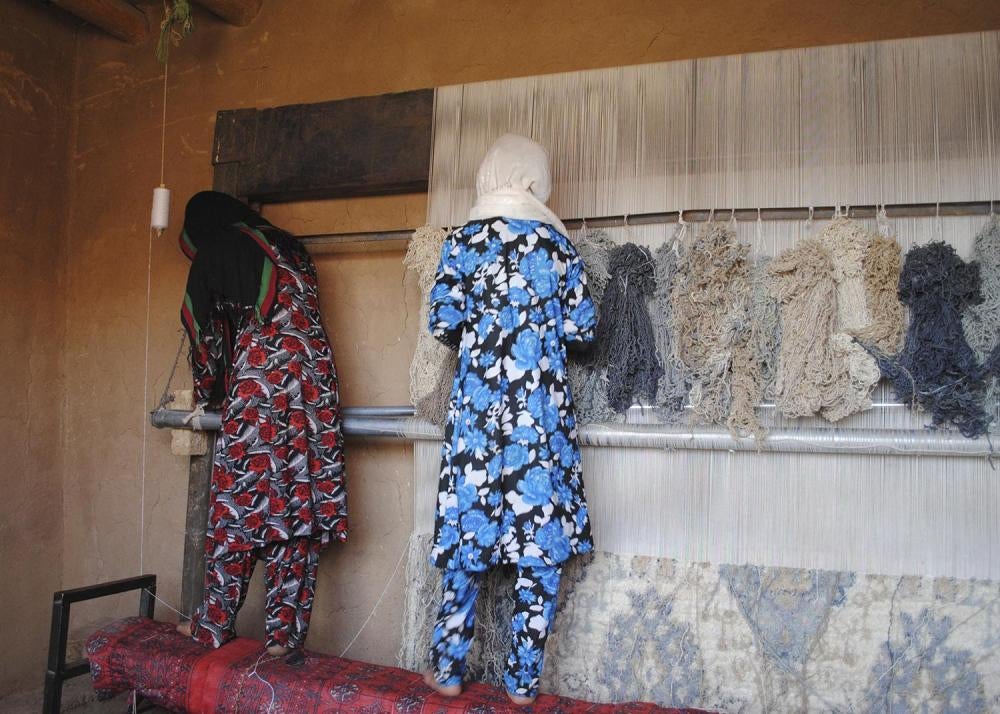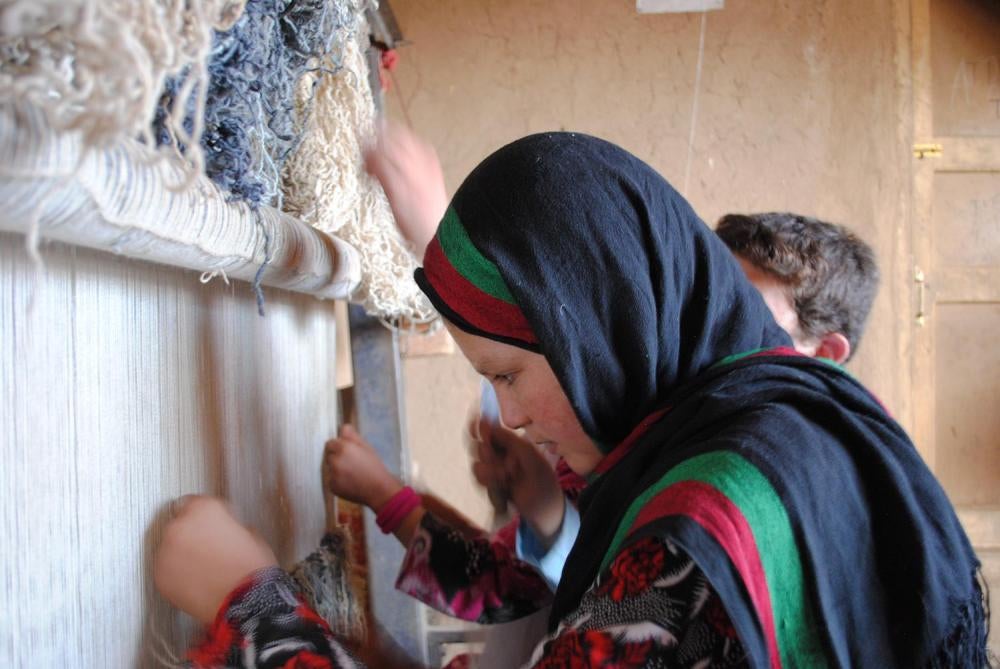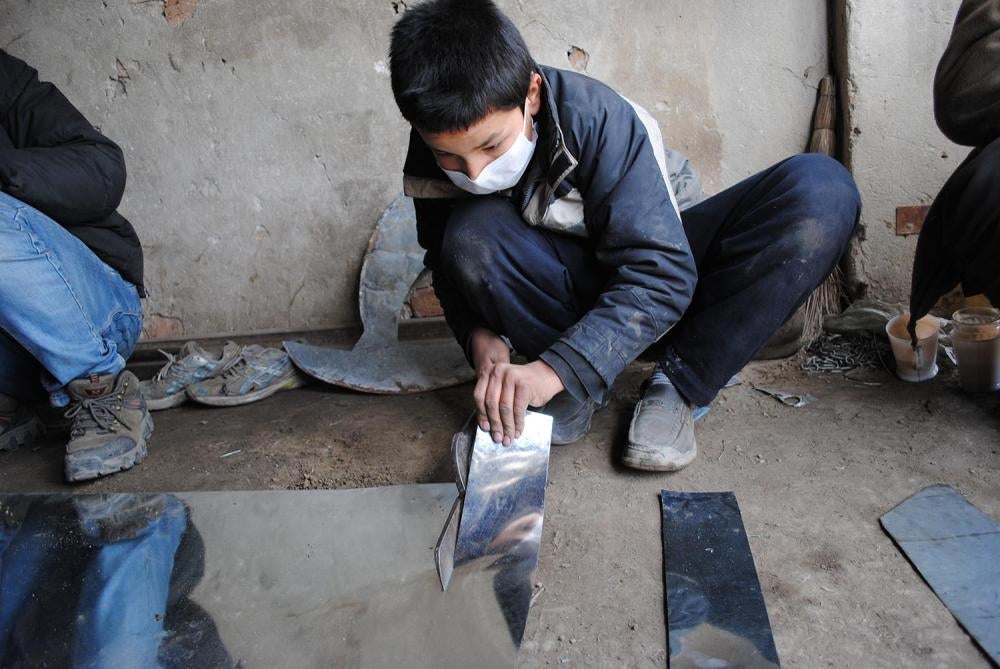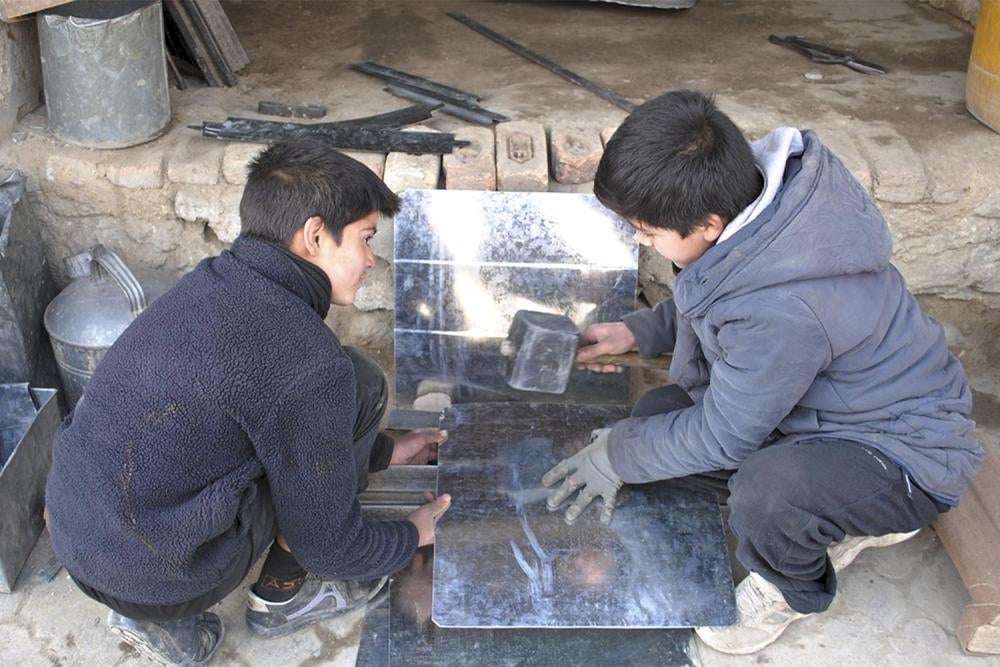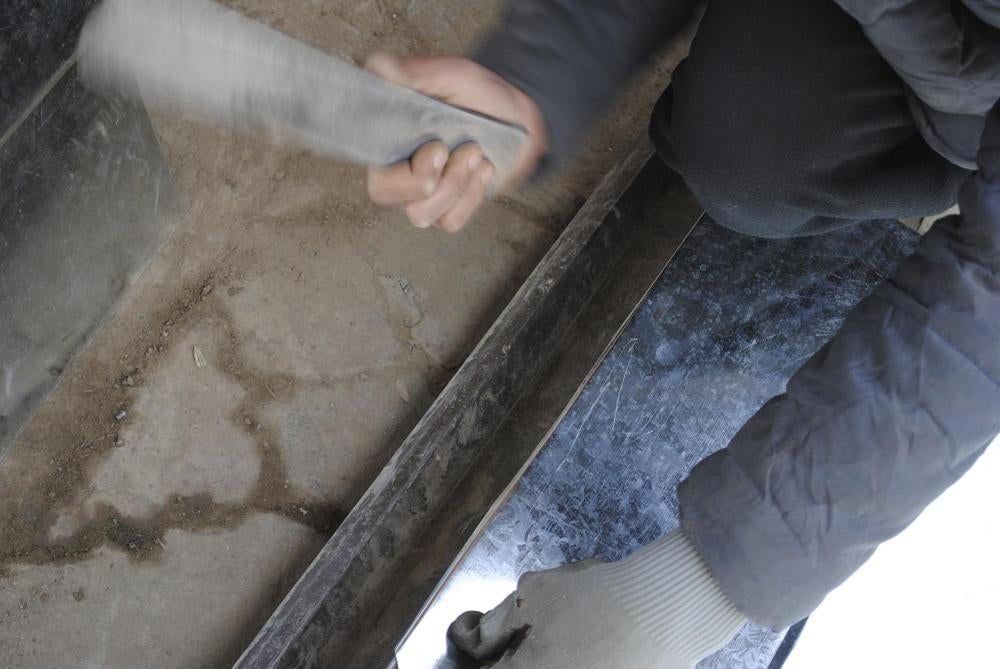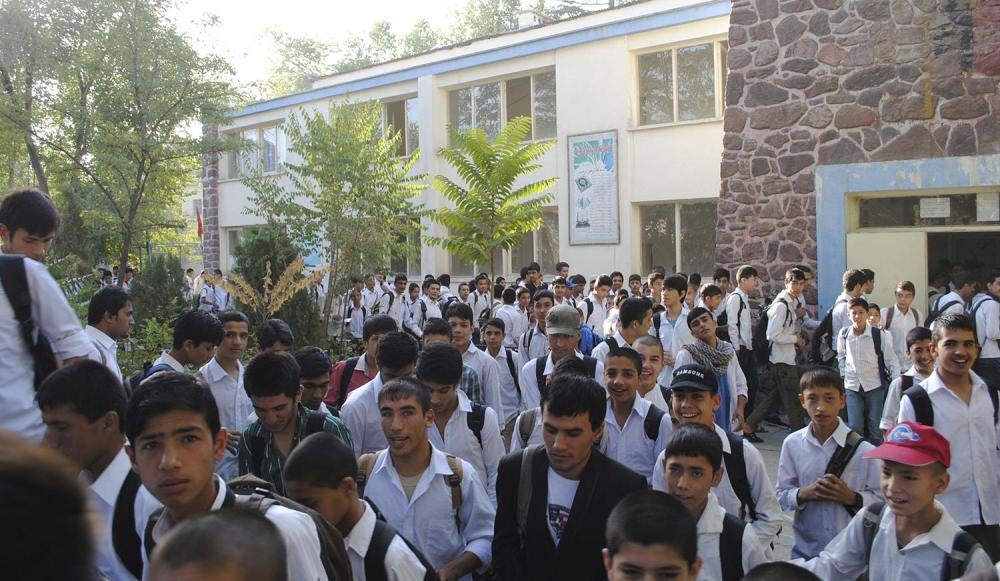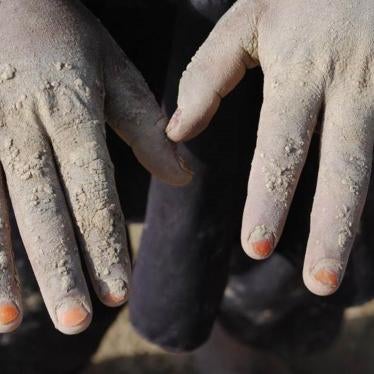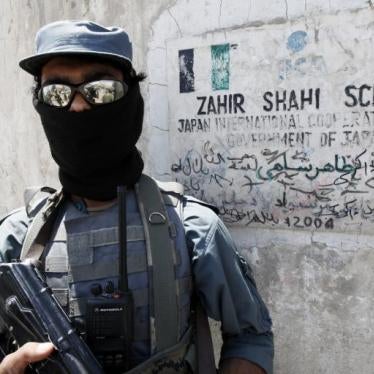Summary
Yes, [the child workers] complain of pain, but what can they do? The kids are here to make a living. They bear all the pain to do all the work.
–Sher Khan, brick kiln manager, Kabul, September 2015
At least a quarter of Afghan children between ages 5 and 14 work for a living or to help their families.[1] Many are employed in jobs that can result in illness, injury, or even death due to hazardous working conditions and poor enforcement of safety and health standards.[2]
Children in Afghanistan generally work long hours with little or no pay. They work in the home-based carpet industry; as bonded labor in brick kilns; in the metal industry as tinsmiths and welders; in mines; in agriculture; and on the streets as vendors, shoe shiners, and beggars. Work forces children to combine the burdens of a job with education or prevents them from going to school altogether. Work induces many children to leave school prematurely. Only half of Afghanistan’s child laborers attend school.[3]
The extreme poverty of Afghan families drives many children into hazardous labor. Afghanistan remains one of the poorest countries in the world.[4] Landlessness, illiteracy, high unemployment, continuing armed conflict in much of the country, and a corresponding lack of able-bodied male adult workers in many families are among the most important factors contributing to chronic poverty and, by extension, child labor.[5]
Not all work by children is considered harmful. When work is appropriate to a child’s age and takes place under healthy and safe conditions, it can be beneficial to the child’s development and allow them to contribute to their family’s basic needs. But work that interferes with a child’s education, or is likely to jeopardize their health or safety, is generally considered “child labor,” and is prohibited under international law.
Under Afghanistan’s Labor Law, 18 is the minimum age for employment. Children between the ages of 15-17 are allowed to work only if the work is not harmful to them, requires less than 35 hours a week, and represents a form of vocational training. Under the law, children 14 and younger are not allowed to work.[6] In April 2010, Afghanistan ratified both of the key international treaties related to child labor: International Labour Organization (ILO) Convention No. 182 on the Worst Forms of Child Labor, and Convention No. 138 on the Minimum Age of Employment. Despite these domestic laws and international obligations, child labor, including in some of the country’s most hazardous industries, is widespread in Afghanistan.
Government officials contend that budgetary constraints and lack of capacity lie behind the government’s inability to enforce labor laws. A spokesperson for the Ministry of Labor, Social Affairs, Martyrs and the Disabled (the “Labor Ministry”) told Human Rights Watch: “Unfortunately, we have not even had the minimum budget for social support programs. This is mostly because the national budget was mostly spent on security and less on social issues, particularly vulnerable children.”[7]
The United Nations Children’s Fund (UNICEF) believes that both the Afghan government and its donors have given “low budget allocations” for the social protection of vulnerable children.[8] Social support programs such as education, legal advice, and health services can help alleviate the effect of child labor or help transition a child laborer out of a hazardous or abusive situation. UNICEF-compiled statistics show that only 1 percent of the national budget is allocated to social programs, which fund most of the child protection programs such as shelter, psychosocial support, and legal advice.[9] While a lack of resources represents an important factor in the persistence of child labor in hazardous industries, the Afghan government has also failed to implement its labor laws through inspections of worksites, penalties for violators, and a strategy to end exploitative labor conditions.[10]
Recent figures for child laborers are not available, but the Afghanistan government’s 2010-2011 Multiple Indicator Cluster Survey found that 25 percent of children between the ages of 5 and 14 are involved in child labor, including 27 percent of those between the ages of 5 and 11, and 22 percent of those between the ages of 12 and 14.[11] A 2013 survey by the Afghanistan Independent Human Rights Commission (AIHRC) put the number of children working “in one way or another” at 52 percent.[12]
Children working in brick kilns represent a stark example of the problem. Rahimullah, 15, has worked as a brick maker for five years with his father and older brother, 18, and his younger siblings. They start the day at 4 a.m. and end it at nightfall. Every member of the family works. Rahimullah told Human Rights Watch:
My smaller siblings also work. When they turn five, they start working. That’s when they start. It’s not just one thing we do; there are a lot of things to do in the brick business – go clear the ground, take the shovel, bring the pickaxe, do this thing, bring me the bucket… the point is, everyone works.[13]
Like Rahimullah, many Afghan children work long hours in physically demanding situations. The AIHRC found in the 2013 survey that 29 percent of working children felt the work they did was harmful to their health.[14] Child workers often face conditions that expose them to physical injury, long-term developmental harm, and psychological strain.[15]
Overall statistics about harm are not available, but in 2014 the Afghan government published a list of 19 hazardous occupations prohibited for children.[16] These jobs include carpet weaving, metal work, and brick making. Children working in the carpet sector, for example, face physical injury such as carpel tunnel syndrome, neuralgia, and swollen finger joints from long hours sitting at the loom and performing repetitive motions with sharp equipment.[17] They also risk eye strain from close work in poor lighting, and respiratory problems from inhaling fine wool dust. Children employed in brick kilns also risk respiratory illnesses and heat stroke.[18] Children working in the metal industry are exposed to dangers such as cuts and burns from welding and cutting sheet metal.[19]
A school principal in Kabul described the experience of one of his students:
Two years ago, we had a student who was in 10th grade. He worked on Asmayee Road [in Kabul] at his family shop selling oxygen tanks. In an accident, a gas tank in the shop exploded. Our student lost an arm and a leg. Even his face was burned. He received a major blow. After three to four months of treatment at the International Committee of the Red Cross, he returned to school with a prosthetic arm and leg. Such incidents are numerous in Kabul and in all 34 provinces because people are poor. And children and students have to do all kinds of hard labor to support their family and parents. When I saw this student, I was very sad. We have many students who sell gas tanks, work on the streets, and in shops and mechanics’ workshops.[20]
A Labor Ministry spokesman also cited the lack of knowledge about children’s rights among families as an important factor:
A more serious problem is the lack of awareness among the people about the rights of children. This is a greater cause of [producing] vulnerable children, particularly working children. In other words, families rarely make decisions [about children] based on an awareness of the rights of the child.[21]
This report examines child labor in brick kilns, carpets, and metal works. It is based on a wide variety of primary and secondary sources, including 25 interviews with child workers, their parents, and employers.
Between July 2015 and January 2016, Human Rights Watch interviewed 15 male and female child laborers and 10 parents and employers in various locations in Bamiyan and Kabul. The children were all between the ages of 5 and 16 when we spoke with them. Human Rights Watch did not pre-select the child workers. All interviews were voluntary and were conducted in Dari or Pashto. Interviewees did not receive compensation for providing their accounts. The report uses the interviewees’ real names.
Human Rights Watch also interviewed Afghan and American government officials, staff of nongovernmental organizations, UN officials, experts, teachers, members of the Afghan parliament, and journalists. These interviews were conducted in-person, over the phone or through email.
Although eliminating all child labor in Afghanistan will be difficult if not impossible so long as high levels of extreme poverty persist in the country, the government can and should take immediate action to eliminate hazardous child labor. Its national laws as well as its international law obligations demand no less. Both Afghanistan and its donors should take urgent steps, detailed at the end of this report, to protect children from the risks associated with working in particularly dangerous or unhealthy conditions.
Recommendations
To the Afghan Government
- Adopt measures outlined in this document to better implement Article 13(4) of the Labor Law, which prohibits the hiring of children under 18 in jobs that are “injurious to their health and cause physical damage or disability.”
- Seek to increase the number of labor inspectors to adequately cover the entire country, giving priority to monitoring hazardous sectors.
- Amend the Labor Law to empower the Ministry of Labor, Social Affairs, Martyrs and the Disabled to fully monitor and enforce provisions related to child labor. Ensure labor inspectors are trained and empowered to detect and respond to child labor situations.
- Ensure broad consultation with civil society groups and activists and incorporate robust child protection measures in the draft Child Act.
- Expand social support services for children working in circumstances harmful to their physical and developmental wellbeing. Fully implement the 2007 National Strategy on Children at Risk and the 2009 National Strategy on Street Children so that children working under hazardous conditions can be identified and offered necessary services such as shelter, medical care, and educational support.
- Expand the Child Protection Action Network (CPAN) to all of Afghanistan’s 34 provinces to effectively monitor and respond to at risk children. In the short term; improve coordination among the network, provide training to observers, and hire technical advisors for all provincial CPANs. In the long term, devise plans to integrate CPAN into the government structure. Provide CPAN members and technical assistants with training on the country’s labor laws and child labor regulations, and on how to identify illegal and harmful labor practices.
- Improve coordination of child labor enforcement across ministries, including the Ministry of Mines; the Attorney General’s Office; the Ministry of Education; the Ministry of Public Health; the Ministry of Justice; the Ministry of Commerce and Industries; and the Ministry of Labor, Social Affairs, Martyrs and the Disabled.
- Work with the Afghan Chamber of Commerce and Industries and other trade associations to encourage compliance with the Labor Law and discourage the hiring of children in hazardous work. Offer necessary information and support to small business owners to reduce the hiring of children in hazardous work.
- Carry out national awareness campaigns to educate parents about the harms of child labor and the importance of schooling.
- Increase working children’s access to schools. Provide accessible and flexible educational services for working children who cannot access the formal schooling system.
To Foreign Donors and UN Agencies
- Offer the Afghan government targeted technical assistance in devising and implementing policies, standards, and regulations against child labor.
- Support the Afghan government in implementing policies that address child labor or offer rehabilitation and support to children engaged in the worst forms of child labor, such as the National Strategy on Children at Risk and the National Strategy on Street Children.
Bonded Labor in the Brick Kiln Industry
There are children here, starting from 10 years or 8 years of age to 15 or 16… They wake up at 3 in the morning and work until about evening… They’re so poor, they can’t do anything else, so they work in the brick kilns of Jalalabad [and Kabul]. All their lives, they’re out like that, working at the kilns… One who starts brick making doesn’t do anything else.
–Sher Khan, brick kiln manager, Kabul, September 2015
Bonded labor refers to the phenomenon of working in conditions of servitude to pay off a debt.The worker is retained as collateral and tied to the work until the debt is repaid.[22] Often the debts are passed onto subsequent generations.[23] Bonded child labor is included in Afghanistan’s 2014 list of work that is considered hazardous and therefore prohibited for children. Afghanistan’s labor law also prohibits “forced” work, which it defines as activities performed under threat or against the will of the worker.[24]
Unlike some other countries in the region, bonded labor is uncommon in Afghanistan and is known to be prevalent only in the brick kilns around Kabul and in the southeastern Nangarhar province.[25] According to a 2011 International Labour Organization (ILO) study, most Afghans working in brick kilns in Afghanistan were laborers who fell into debt bondage when living in Pakistan as refugees or migrants.[26] In Afghanistan, such families work in different locations according to the season, spending the summer in Kabul’s Deh Sabz district and the winter in the Surkhrod district of the warmer Nangarhar province. Each kiln may employ 10 to 30 families living on-site; in Deh Sabz and Surkhrod, there are hundreds of brick kilns.[27] Children work alongside their debt-bonded laborer parents. The entire family lives on the worksite, which makes it easier to keep the children “at work” even during off hours and weekends.[28]
Children as young as five commonly work in brick kilns.[29] The work is punishingly exhausting and the hours are long. Boys and pre-adolescent girls work 10-15 hours a day, typically with no shelter and in direct exposure to the sun and dust. Younger children help with clearing the fields of rubble, arranging the dried-out bricks in stacks, fetching water to make clay, and bringing sand to lay under the bricks.[30]
Malang, 40, tasks his three sons, ages between 12 and 16, to load bricks onto trucks.
We do the loading work whenever the trucks come. It’s usually from 8 a.m. to 5 or 6 p.m. But in the summer, they can come at any hour, so we load day and night, 24 hours. We work every day of the week. We do not have Thursdays or Fridays [off]. Some days, we load 30 to 35 trucks. The smaller trucks hold 3,000 bricks; the larger ones hold 15,000 bricks.[31]
Limited Access to Education
Debt-bonded families in Kabul’s brick kiln industry typically work from March to October and then travel to work in the brick kilns in the warmer climate of Nangarhar the rest of the year. The seasonality of the work is one reason children do not go to school, another being that families need all children to work as many hours as possible to help pay off the family debt. Parents rely on their children to contribute to the families’ work, and cannot afford the costs of transportation and fees to send the children to school, or the opportunity cost associated with school attendance.[32]
To address the needs of children working in brick kilns, UNICEF and the Afghan Ministry of Education in 2010 established a project in the Surkhrod area of Nangarhar to offer community-based schools near brick kilns for children up to Grade 3. The Surkhrod schools are among 3,700 pilot schools serving marginalized communities in remote, insecure areas in Afghanistan.[33] Students in these community schools are normally transitioned to the nearest government school from Grade 4. According to UNICEF, as of December 2015, of the 380,000 students who studied at these pilot schools since the project was launched in 2010, more than 130,000 transitioned to fourth grade.[34] It is unclear how many of these students were brick kiln workers, but the ILO states that the program has laid groundwork that will be “invaluable” for additional interventions to help such children.[35]
In all, some 10 percent of children in the Surkhrod brick kilns attended school as of 2011; the figure for children working in brick kilns in Kabul, where UNICEF’s Community Based Schooling (CBS) program is not active, is more limited at 5 percent.[36] Family members told Human Rights Watch that the Afghan government had made no effort to establish schools close to the brick kilns in Deh Sabz, a district northeast of Kabul city, where many of the brick kilns have been established.[37] The Ministry of Education, which coordinates the donor-funded CBS program, has stated that it has identified Deh Sabz as a CBS location, but has been unable to attract donors to build schools.[38]
Several child workers at the brick kiln in Deh Sabz told Human Rights Watch that none of them attend school because there are neither formal schools nor CBS schools in that area.[39] Hazrat Hussain, 12, has been working for a year to help his father pay off his debt. Hazrat Hussain studied until third grade when the family was in Pakistan. He does not go to school now that the family lives in Kabul.
“I work, that’s why I don’t go to school,” he said. “My older brothers, Shahid and Moin, also don’t go to school because they work.”[40]
Negative Health Impact
Children working in brick kilns suffer illness or injuries more frequently or with more long-term consequences than do their adult counterparts.[41] Because of the hard physical labor, long hours, and dangerous conditions, children risk experiencing heat stroke along with other illnesses including malaria (transmitted by mosquitoes breeding in stagnant water found near many brick kilns) and respiratory diseases including asthma and silicosis due to breathing in brick dust.[42]
The combination of healthcare costs and lost labor adds to the families’ financial burdens and makes it harder for them to repay their loans. According to Rahimullah, 15, a brick maker: “Every week there’s one or two who’s sick. There’s 20 kinds of sicknesses, they get a cold or something. Every week one of the younger ones is sick and the doctor asks for 700 or 800 Afghani [approximately US$12].”[43]
Children in the debt-bonded brick kiln sector normally work six days a week. Although Friday is technically a day off, even on Fridays they often do some work to prepare for the following week’s work, such as digging fresh dirt for the clay, preparing the clay, and clearing the field on which to lay new bricks.[44]
Child Labor Abuses in the Carpet Industry
I cough, and my three sisters cough. We don’t get medicine for it. When I breathe, the particles of yarn stick to my throat, then I get a cough. I have been coughing for about six years. The hook-blade with which we work has also injured my sisters. My uncle’s son in Kabul was young – maybe he was 7 – and working as an apprentice in Kabul when he hurt his eye. He went to the doctor who bandaged it.
—Aziz, carpet weaver, Bamiyan, September 2015
Carpet weaving is one of Afghanistan’s main cottage industries, with looms commonly placed inside homes where children work long hours. Because of the home-based nature of the work, the carpet industry has a particularly high percentage of girl laborers (58 percent girls compared t0 41 percent boys, according to a 2008 study).[45] Because the carpet industry is not seen as physically demanding, it has the highest rate of child participation, with 93 percent of child workers in the carpet sector begin work between the ages of 5 and 11.[46]
The main weaving tool is a hook-blade, a long hook appended to the end of a knife. Because the repetitive action of weaving is conducted at a fast pace, children often miss a stroke or overdo a motion, cutting their hands. Children also described injuring their eyes when the hook catches their eyelid, an injury that takes several days to a full month to heal and often requires medical attention.[47]
Children interviewed by Human Rights Watch in Bamiyan province described work days beginning as early as 5 a.m. and ending at nightfall. These child weavers normally take a four-hour break to attend school, after which they return to work at the loom.
Looms are sometimes located in the same room where the family lives, eats, and sleeps, exposing children to high levels of wool dust for prolonged periods of time, increasing the risk of respiratory illnesses.[48] Child weavers told Human Rights Watch that they suffer persistent coughing because they inhale this fine wool dust, and that such coughing starts soon after they begin their weaving career.[49]
Muhammad Amin Nadim, a carpet contractor who started as a weaver two decades ago, said that masks are becoming more common and some weavers visit doctors for their cough, but most continue to work despite the cough.[50]
In the past, people didn’t wear masks, but now masks are becoming more common. Only some people go to the doctor because of the coughing. Most people just continue to work and inhale the dust particles and cough. It destroys your lungs.[51]
Child weavers must sit in front of the loom with their heads, necks, and arms aligned in awkward postures which, combined with the repetitive movement of tying knots with non-ergonomic tools, can cause carpel tunnel syndrome, neuralgia, swollen finger joints, eye strain, and premature vision problems.[52]
In 2014, the government added carpet weaving to the list of jobs it deemed harmful to children, but only when performed for more than four hours a day. The reduced hours, if implemented, may go some way in reducing risks of posture-related injuries and other ailments, although many of the health risks remain.
Aziz, 12, has been weaving carpets in his home for six years. He and his 11 siblings are the breadwinners for their family. He goes to school but works before and after school. He works full days during winter holidays. He has been injured several times. “My hands have been cut many times, but I haven’t hurt my eyes yet,” Aziz said. “I cut my finger with the hook-blade when working, but it has healed.” Aziz also has a chronic cough that he said started when he began his weaving work at age 6.[53]
Government enforcement of laws that protect children from hazardous labor is particularly challenging in the carpet sector because of the home-based nature of the industry. It is difficult for outsiders to access households to inspect the looms and sometimes difficult to tell which families have looms that employ children. The government also lacks resources to monitor the sector and enforce labor laws.[54]
The nongovernmental sector has only limited capacity to help monitor the participation of children in the carpet industry. The government-chaired CPAN network has only one NGO member that focuses on the carpet industry.[55] That NGO, GoodWeave, certifies carpet businesses as child labor-free, monitors carpet looms and offers alternative social services such as education to children, but significant obstacles remain.[56] As GoodWeave’s director told Human Rights Watch: “Because there are so many layers of subcontracting, it can be complicated to identify the weaving households, and… there is a lot of movement of both people and looms, so it becomes challenging to track.”[57]
GoodWeave has programs in five of Afghanistan’s 34 provinces.[58] It is able to gain some access to weaving households because it signs license agreements with US and European importers, stipulating that their supply chains be opened up to monitoring. This allows female monitors in Afghanistan to gain access to the carpet-weaving households. A GoodWeave representative explained:
Because the international buyer has requested and requires the monitoring, the exporter and subcontractors are willing to comply. In Afghanistan because we are working at the household level, we use female monitors. They work almost like social workers, visiting families to understand the household needs and challenges. We work with them over time to try to reduce children’s working hours, ensure that the children have access to education, and link the families to other social services.[59]
GoodWeave uses its access to persuade families to send their children to local schools, community-based classes or, in case of girls, GoodWeave-run homeschools.[60]
Child Labor Abuses in the Metalwork Industry
I have hurt my hands five times. My fingers have been cut from the sharp edges of the metal and slammed by the hammer. My finger has also been caught in the trimming-beading machine. When your nail gets hit by a hammer or caught in the machine, it becomes black and eventually falls off.[61]
–Hamid, 13, metal worker, Kabul, January 2016
Children working in the metalwork industry in Afghanistan are engaged as apprentices making items such as gates, doors, water tankers, and windows.[62] The work involves cutting sheets of metal, welding, lifting heavy items, and using dangerous items such as hammers, anvils, chisels, and blowtorches.[63]
Children start early in this trade. According to an ILO survey, more than 60 percent of the child metal workers in Kabul started work between 5 and 11 years of age.[64] These children are exposed to dangers including severe burns, cuts and vision problems, high noise levels, long working hours, heavy loads, and unsafe equipment.[65] One child worker told Human Rights Watch that children in the metal industry below the age of 10 perform mostly “support” roles that involve fetching water, holding metal bars together for welding, making tea, or light lifting and hammering.[66]
The ILO study found that 80 percent of children employed in metal workshops handled “dangerous machinery and fire,” with 20 percent engaged in cleaning or other services.[67] Even very young children employed in metal workshops are exposed to risks of bodily injury, including general workplace hazards such as falling objects, extreme seasonal heat and cold, and direct sun exposure because much of the work takes place outside or in workshops with no heating. Other risks include unprotected welding, which may result in severe burns and vision problems.[68]
Human Rights Watch also found that, beginning in their teenage years, children routinely carry out the full range of often hazardous tasks in metal work. They cut metal sheets using sharp metal cutters designed for adult hands, weld metal parts together, and carry and stack metal gates and window frames.
Sajjad, 13, has been a sheet metal worker for three years. He works six hours a day and goes to school in the morning. Sajjad told Human Rights Watch that during his work day he routinely receives cuts, including a major injury sustained in 2014:
In the previous shop [where I worked], the metal sheet cut my leg. I get lots of cuts, but that time the sheet cut my leg. It was a big cut. The sheet was on the shop floor. When I was walking by, my leg caught on it and got a big tear. My boss took me to the neighborhood pharmacy.[69]
Sajjad said that local clinic bandaged the wound. The scar, approximately five centimeters long, is still visible on his shin.
Sayed Omid, 18, owns a sheet metal workshop and has worked in the trade since he was 6. He has never attended school because “I never liked school and nobody asked me to go.”[70] Sayed Omid has suffered work injuries several times, including a knee injury in 2014:
A year ago, I was on top of a two-story building to install a sheet metal roof. It was winter and there was snow and everything was wet. I slipped and fell down two stories. I dislocated my knee. I couldn’t work for 15 or 20 days. Even now, when the weather is cold, my right knee hurts.
The Afghan government prohibits children from working at heights above three meters, and from welding, cutting, and using trimming-beading machines. But there is no evidence that any of these provisions is enforced and children too often are asked to perform such tasks, making much of the work in the metal sector illegal.[71]
Afghan Legal Context
Afghanistan’s Labor Law forbids child labor; in addition, the country is party to international treaties that restrict or limit the employment of children.[72] Nevertheless, 25 percent of Afghan children between the ages of 5 and 14 work, in violation of laws setting 15 as the minimum age for employment.[73] Older children often work longer than the legal limit of 35 hours a week and often without any days off.[74] There are no reliable statistics about the percentage of children employed in hazardous forms of work, which is defined under International Labour Organization (ILO) Convention No. 182 on the Worst Forms of Child Labor as “work which, by its nature or the circumstances in which it is carried out, is likely to harm the health, safety or morals of children.”[75]
The Labor Ministry has primary responsibility for enforcing labor laws but has limited resources to inspect workplaces. The Labor Ministry says it has 28 labor inspectors; however, all of them are based in Kabul and make few if any inspection trips to the country’s 34 provinces.[76] As the Labor Ministry does not have a program to monitor child labor, Afghanistan’s default mechanism for monitoring and responding to concerns about vulnerable working children is the Child Protection Action Network (CPAN), a coalition of international and Afghan nongovernmental organizations (NGOs) and relevant government ministries.[77]
CPAN, which is chaired by the Labor Ministry and subsidized by UNICEF, works in 31 of Afghanistan’s 34 provinces and has about 15 to 30 members in each province, depending on the availability and participation of members.[78] Each provincial CPAN should have a “technical assistant” to coordinate its work; as of April 2016, 18 of the 31 provincial CPANs had technical assistants.[79] CPAN has a broad child protection mandate that covers issues such as recruitment of child soldiers, forced and underage marriages, and child trafficking, in addition to vulnerable working children,[80] so it conducts only very limited inspections of workplaces for child labor violations.[81]
Over the last four years, CPAN has helped an average of 3,000 children a year.[82] When CPAN identifies a vulnerable working child, it refers the child to NGOs or government agencies that provide relevant support, including legal aid, shelter, and social services such as health and educational support.[83] Provincial CPAN members and technical assistants do not receive training on the country’s labor laws or child labor regulations, limiting their ability to identify illegal and harmful labor practices.[84]
In 2012 and 2013, the government of Afghanistan, in collaboration with the ILO, began drafting a revised labor law to bring it in line with the ILO standards Afghanistan had ratified.[85] These revisions included amendments aimed at improving labor enforcement mechanisms.[86] However, in November 2015, under a new legislative director, the Labor Ministry scrapped the previous review and conducted a second review to draft a new set of provisions for labor law enforcement.[87] A senior ministry official told Human Rights Watch that it planned to obtain feedback on this draft from Afghan and international NGOs, donors, and the private sector before sending it to the Ministry of Justice, which prepares and forwards legislation for further approval by the Council of Ministers and the parliament.[88] The ministry did not specify when this request for feedback was likely to come.
In February 2014, Labor Ministry published a list of nine sectors and 19 jobs where child labor was prohibited because the work was injurious to the health and wellbeing of children.[89] Among these were carpet weaving for more than four hours a day, mining, welding, working at metal factories, and employment in brick kilns.[90] The draft law also prohibits bonded labor of children, and employing children between 7 p.m. and 6 a.m.[91] The list included no provisions for enforcement, and no enforcement provisions have been developed since.
Article 146 of the Afghan Labor Law tasks the Labor Ministry with “continued monitoring and observing” of labor laws, but it leaves the specifics of the task to “respective legislative documents,”[92] which as of April 2016 had not been drafted or finalized. As a result, the Labor Ministry lacks sufficient legal authority to enforce laws related to child labor.[93]
Since 2013, the Ministry of Justice, in coordination with UNICEF, has been drafting new legislation, the Child Act, to legally codify issues of child protection and address issues including trafficking, custody, sexual exploitation, education, and labor. Since early 2014, when then-Minister of Justice Habibullah Ghalib brought the drafting under the Ministry of Justice’s direct purview, NGOs have not had access to the drafting process.[94] The Ministry of Justice says it plans to finish drafting the Child Act in 2016 and will share it with NGOs for feedback.[95]
With technical assistance from UNICEF and other organizations, the government has also developed a National Strategy for Children at Risk, and a National Action Plan for Street Working Children, aimed at providing social services to children, protecting children engaged in labor, and preventing children from working on the streets.[96] According to the Labor Ministry, the government has struggled to raise enough funds to implement both of these plans effectively.[97]
However, resource constraints represent only part of the problem. A lack of coordination within the government also hinders effective enforcement of existing labor laws. Children work across multiple sectors, requiring the cooperation of a range of ministries to implement laws that provide for children’s protection. The lack of coordination in the mining industry exemplifies the problem. Because the Ministry of Mines and Petroleum has sole authority for regulating the mining sector, the Labor Ministry has no mechanism for detecting and preventing children’s employment in mines. In addition, if the Mines and Petroleum Ministry shuts down an unlicensed mining operation, it lacks the structural coordination to refer any children who might be employed in that mine to the Labor Ministry for necessary social welfare support such as educational assistance, health checks, or psychological counseling.[98]
Afghan government data indicates that as of mid-2016, 50 national and international NGOs were working in child protection and welfare services across Afghanistan.[99] CPAN offers limited coordination between these organizations and the government on child protection work. But a Labor Ministry official and NGO representatives told Human Rights Watch that more systematic and efficient cooperation between them is necessary to avoid gaps in services and duplication of efforts.[100]
Conclusion
The government of Afghanistan has failed to enforce prohibitions against child labor in hazardous industries, and has stalled in its effort to overhaul its own labor law to bring it into line with international standards. Government institutions responsible for enforcing the law lack the capacity to carry out inspections of workplaces, with the result that children working in prohibited lines of work go unnoticed and unprotected.
Poverty is the principal reason children work; in turn, child labor perpetuates poverty by interfering with working children’s education. Although pilot projects extending community-based schools to reach vulnerable children have been promising, support for these schools is inadequate to the need. Eradicating child labor in Afghanistan is not feasible so long as extreme poverty continues, but the government and its donors can and should take immediate steps to eliminate hazardous child labor and protect children from the risks associated with working in particularly dangerous or unhealthy conditions. They should also devote more resources to expanding educational support to all working children.
Acknowledgments
This report was researched and written by Ahmad Shuja, Afghanistan assistant researcher at Human Rights Watch. It was edited by Patricia Gossman, Afghanistan senior researcher; Phelim Kine, deputy Asia director; Jo Becker, advocacy director, Children’s Rights Division; and Richard Pearshouse, senior researcher, Health and Human Rights Division. James Ross, legal and policy director, and Joseph Saunders, deputy program director, provided
legal and program reviews. Production assistance was provided by Daniel Lee, associate with the Asia division; Olivia Hunter, publications associate; and Fitzroy Hepkins, administrative manager.
